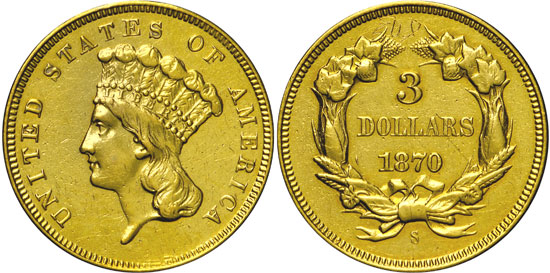Background and History
The 1870-S Three Dollar Gold Piece is well-known among collectors as a potentially unique rarity with an intriguing backstory. General O.H. LaGrange, the Superintendent of the San Francisco Mint, indicated that only a single specimen of the coin had been struck for inclusion within the cornerstone of the new mint building. However, in 1911 an example appeared within the William H. Woodin Sale, which was claimed to be a duplicate of the coin. For a time, it was believed that two examples of the coin existed, although today it is widely recognized that the two coins are one and the same. Thus, only a single example of the mysterious coin is known to exist.

The Three Dollar Gold Piece had been introduced in 1854 and was struck until 1889. The creation of this odd denomination was directly related to the postage rate of the time. In the 1850’s, it cost 3 cents to send a letter by first class mail, and the $3 gold coin was introduced to facilitate the purchase 100-count sheets of postage stamps. The denomination would see limited use and by the final decade of the series, the coins were mostly struck for collectors.
The introduction of the denomination roughly corresponded with the founding of the San Francisco Mint in 1854. After striking coins for a number of years, the mint would outgrow its facility due to the large influx of gold coming out of the Sierra mining region. In 1870, construction of the second San Francisco Mint building would commence, while limited production continued at the existing building. Included in this production was an example of almost every denomination to be placed in the cornerstone of the new Mint on Fifth Street.
Key Date Coin Mintage
The circumstances of the mintage of the 1870-S Three Dollar Gold Piece were somewhat unusual. At the time, it was customary for the Philadelphia Mint to prepare dies for coins to be struck at the branch mints, add the proper mint marks, and then ship the dies to each location. Due to an oversight, the dies for the 1870-S Three Dollar Gold Coin were sent to San Francisco without the mint mark. Rather than sending the dies back to Philadelphia, the Superintendent of the San Francisco Mint had the coiner engrave an “S” at the bottom of the reverse die to allow the striking of a ceremonial coin for inclusion in the cornerstone of the new mint building.
The exact mintage of the 1870-S Three Dollar Gold Coin remains unknown. For a time, it was believed that a total of two coins had been struck. These pieces would have been the coin laid in the cornerstone as well as the coin from the 1911 Woodin sale. However, most researchers now believe that the two coins were one and the same, and only one coin was struck. In either situation, only a single example of the coin is currently known to exist leading to its status as a unique rarity.
Finest Known and Values
The sole known example of the 1870-S Three Dollar Gold Coin is graded an estimated EF-40, although it does have some conditional issues, which would preclude it from receiving an official grade at this level. Most noticeably, the numbers “893” have been scratched into the upper field on the reverse. Additionally, the coin was once used as jewelry and shows evidence of a suspension loop having been applied and later removed from the top edge.
Despite its flaws, the 1870-S Three Dollar Gold Piece has brought sharply escalating prices over the course of its few public sales. At its first appearance within the William H. Woodin Sale of 1911, the coin sold for a price of $1,450. In 1946, Louis E. Eliasberg purchased the coin for $11,500. Eliasberg would famously assemble the only complete collection of United States coins with this rarity included. When the collection was eventually dispersed at auction in 1982, Harry Bass purchased the coin for $687,500 after much spirited bidding.
While most of the Bass collection was sold after his death, the unique 1870-S Three Dollar Gold Piece was not. The coin currently resides within the collection of the American Numismatic Association and is on permanent display. It seems unlikely that the ANA will offer the coin for public sale at any time in the future. Most likely, the 1982 auction will represent the final public sale for a coin that is permanently off the market.

